Introduction
Differentiation means that classroom learning is tailored to meet individual student needs. This is particularly important for students who experience learning delays, face barriers, or have other special needs. Module 7 offers suggestions for ways to adapt learning material in a language classroom so that all students can experience success at school.
When considering the range of diverse language learners in today’s classroom, teachers may want to seek answers to a few key questions:
- Who is in the room?
- What do I know about my students, their families and their lives outside the classroom?
- Are their any identified special needs among students?
- Have students studied this language before?
- Have students had an initial language assessment? If so, what is their language proficiency level?
Answers to these questions, much like answers gained in the initial assessment process, will guide teachers in the selection of appropriate resources, instructional strategies and varied assessments. In other words, teachers will be able to design lessons that are intended for diverse students.
The module begins with a rationale for creating learner profiles. This is followed by an exploration of factors that may impact student learning, including individual learning styles. Some ideas for differentiation in the language classroom are shared, based on an adapted framework of quadrants from the The Adaptive Dimension (Saskatchewan Ministry of Education, 2017). The ministry’s framework organizes learning adaptations into four categories: instruction, assessment, environment, and resources.
The goal of differentiated instruction is to give each learner the kind of help they need in the classroom. Not all that long ago, the school curriculum focused on equality, which meant giving each student the same textbook, the same workbook, and the same assessments. Educators now understand that students are very diverse! One size does not fit all when it comes to learning at school. Students can work toward the same curriculum goals, but the process of learning can be adjusted to help students where help is needed most.
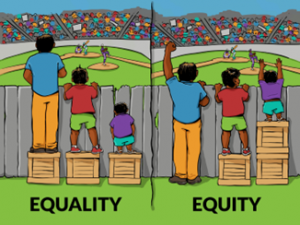
Source: Permission: CC BY-SA 4.0 Courtesy of Interaction Institute for Social Change | Artist: Angus Maguire
The Learner Profile (Learner Portfolio)
How much do you know about each student in your language classroom? What background experiences have students had with the language being learned? What is their level of academic performance in other subject areas at school? Is the student experiencing any academic challenges in the mainstream classroom? Answers to these questions can shed light on a student’s performance in the language classroom.
A learner profile (or learner portfolio) is a collection of important information about the student. It includes information about previous language learning experiences, as well as language tasks completed during the school year. The collection often contains the results of an initial assessment (explained in a previous module). This assessment offers a snapshot of the student’s language skills at the outset of the learning program. Samples of ongoing assessments given throughout the year illustrate where and how progress has been made.
Student portfolios can be created using a file folder, artifact box, or album.
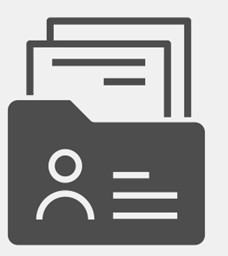

Source: Permission: CC BY-SA 4.0 .Courtesy of Vector Stock. Source: Permission: CC BY-SA 4.0 Courtesy of Creazilla.
The CEFR/CFR Language Reference Scale (N. Prokopchuk, 2021) provided in Appendix B contains space to record details about each student’s language level at the beginning and end of a school term. Evidence of progress throughout the year can be gathered through observations, anecdotal evidence, assignments, demonstrations, projects, or other classroom tasks. Selected tasks or assignments can be stored in the learner’s profile to illustrate incremental (‘slow but steady’) language growth during the year.
Factors That May Affect Language Progress
What happens when a student seems to be lagging behind or showing minimal signs of progress with language learning? What if a student is switching languages or mixing languages? What if a student is silent or hesitant to speak? Could there be a learning challenge, a hearing impairment, or a speech language impediment (SLI)? Some of the reasons for language challenges and delays are explained below.
A. Silent Period
In the initial stages of language learning, students may go through a silent period. Some students feel anxious, shy, or hesitant about speaking in the new language, particularly in front of their peers. The silent period can last for several weeks.
Coelho (2016) states that “It is important not to push beginners to produce language before they are ready. During this time, some language teachers use the Total Physical Response (TPR) method, which allows beginners to remain silent for a significant period… Students who are too intimidated to speak up in class may feel more secure about talking in a small group, where the audience consists of only two or three students.”
If teachers continue to be concerned about a student’s silence, it may be helpful to check the learner’s academic profile in other subject areas or to speak with parents about the student’s openness to conversations at home.
B. Language Distance
There is evidence that language distance (also called linguistic distance) has an effect on the time needed to learn a new language. Language distance is described as the extent to which two languages are similar or different from each other. Languages with the least language distance from English enable EAL learners to reach higher proficiency levels more quickly.
The American Foreign Service Institute (FSI est. 1947) first introduced the notion of language distance in connection with their language training programs for foreign diplomats and military personnel. The FSI created a tiered scale of language categories that estimated the number of hours required by an English speaker to reach a specified speaking and reading level in a new language. The languages were ranked from easiest to most difficult across tiers. The infographic produced by Voxy (see Module 6) reflects the tiered scale introduced by FSI.
The impact of language distance on students learning a new language needs to be taken into consideration when selecting instructional strategies. Most educators agree that students with first languages such as French, Italian, or Spanish adjust to English with greater ease than students from Asian or Arabic language backgrounds. Students whose first language(s) differ greatly from English might benefit from instructional strategies that target the differences through explicit comparisons of oral and written language forms.
C. Fossilization
In a K-12 language class, one teacher can have 20 or 30 students. Given this student-teacher ratio, it is easy for students to pass along language errors, multiplied many times, leading to fossilization of errors. Fossilization is a broad term used to describe recurring errors or incorrect patterns of speech. In essence, errors become imprinted in a student’s mind (like fossil imprints!) due to the number of repetitions from classmates. Language experts believe that fossilization is unavoidable in language classrooms. Some students are more susceptible than others, affecting their ability to develop fluency and accuracy. Teachers need to address errors by:
- explaining grammatical features of the target language;
- comparing grammatical rules that differ between L1 and L2;
- providing multiple audio and video examples to reinforce correct patterns; and,
- providing tutorials or small group support for recurring errors.
Coelho (2016, pp.172-175) draws attention to the student’s affective filter and the need for teachers to address errors gently.
- Respond to the message first, before focusing on the error.
- Be selective when deciding which errors to address.
- Focus on one error at a time.
- Continue to reinforce the correct patterns over several weeks. Students need time to change deeply rooted fossilized patterns.
The example below illustrates how fossilization can occur. The teacher provides a correct statement. However, student 1 mispronounces the word ‘asking’ and each student repeats the incorrect word, multiplying the error many times! The teacher must then draw attention to the error through one of the strategies mentioned above.
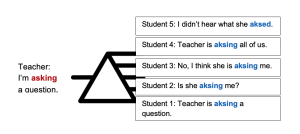
Permission: Courtesy of Nadia Prokopchuk, Department of Curriculum Studies, University of Saskatchewan
Speech Language Impediment or Code-Switching?
To begin this segment, it is best to view a video clip about bilingual children and speech-language impairments (SLI) titled Can bilingual children have speech-language impairments (SLI)? https://www.youtube.com/watch?v=g7Sj_uRV7S4&sns=tw (5:24 min.) prepared by the organization RADLD (Raising Awareness of Developmental Language Disorder).
The video clip introduces the term code-switching, which has often been interpreted as a sign of a language delay or language challenge. Code-switching (also called ‘translanguaging’) involves the use of two or more languages in the context of oral communication. It is a natural phenomenon among simultaneous bilinguals (two languages are learned from birth) and is also common among sequential bilinguals (adding a new language to a first language) as proficiency grows in an additional language. Code-switching reflects a complex and fairly rapid process of analyzing input, creating ‘in your head’ translations and producing oral speech. Code-switching is NOT a sign of a language delay or learning challenge.
Coelho (2016) states “For teachers, understanding the source of a specific error is not as important as knowing how to respond to it. You may remember that your own language teachers seemed to point out and correct your errors constantly. How did that make you feel? Perhaps you responded negatively, feeling intimidated and reluctant to speak. Or perhaps you responded positively, believing that your teachers were providing sound guidance….” (pp. 173-174). Coelho advises teachers to think about errors not as problems, but as markers on the path to making progress in a new language.
Brief video explanations of translanguaging are available here:
- Crisfield, E. (2017). What is translanguaging, really? 1:56 min. https://www.youtube.com/watch?v=iNOtmn2UTzI
- Crisfield, E. (2020). Translanguaging – Why to how. 2:14 min. https://www.youtube.com/watch?v=9-08jDnN9cc&t=18s
Learning Styles
All learners, whether students or adults, have preferred learning styles that allow them to learn new information more efficiently and effectively. Teachers can incorporate a variety of strategies in their lesson plans to support students with different learning styles. A brief summary of learning styles is offered below.
Visual Learners
Students who are visual learners experience greater success when they have items to view during a lesson. Teachers should strive to incorporate photos, diagrams, audio-visual presentations, demonstrations, handouts, displays, flip-chart information, checklists, posters, written directions, or instructions in their lesson plans. The phrase “Let me see it” describes a visual learner.
Auditory Learners
Students who are auditory learners experience success when they can clearly hear information and have opportunities to repeat information presented in the classroom. They have an innate ability to listen both actively and attentively. Auditory learners can comprehend and remember oral directions, instructions given over the phone, details in podcasts, or words to a song heard on the radio. The phrase “Let me hear it” describes a visual learner.
Kinesthetic or Tactile Learners
Students who are kinesthetic or tactile learners are successful with learning when engaged in hands-on tasks. They like to learn as they go by assembling, rearranging, experimenting, building, or designing something. Some learners have difficulty concentrating when seated at their desks. They need to include physical experiences that involve one or several of the senses. Using manipulatives, holding items, movement (exercise breaks), or engaging in hands-on projects supports their learning. The phrase “Let me try it” describes a kinesthetic/tactile learner.
Information in the chart that follows has been adapted from the website of the University of Massachusetts (2022) and their segment titled How to Accommodate Different Learning Styles.
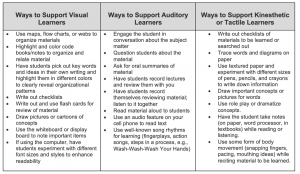
Permission: Courtesy of Nadia Prokopchuk, Department of Curriculum Studies, University of Saskatchewan
A brief video explanation of learning styles is available here:
- GCFLearnFree. (n/d). Discover Your Learning Style. 3:31 min. https://www.youtube.com/watch?v=_IopcOwfsoU
Differentiated Instruction
Differentiated instruction (or differentiation) allows teachers in mainstream classes to plan for diverse student needs through adjustments or adaptations to the learning process, learning products, or learning environment.
When students are language learners, differentiation also requires initial and ongoing language assessment to meet the language needs of each student. Teachers benefit from having an arsenal, or toolkit, of effective strategies that (a) consider the student’s current language skills, and (b) ensure that comprehension and learning are taking place to scaffold learning beyond the current level.
Ways to differentiate learning are described extensively in a document titled The Adaptive Dimension (2017) produced by the Saskatchewan Ministry of Education. This document encourages adaptations in four areas so that the learning needs of diverse students can be met. Variables such as learning styles, interests, cultures, and languages impact the ability to reach curriculum outcomes. The chart that follows is an adaptation of a cross-curricular chart that appears in the Adaptive Dimension document (p.11). Given the focus of this online text, the suggestions in the chart specifically target language learners in schools.
Note that alternative assessment strategies are suggested in the fourth quadrant. This encourages teachers to expand their views by moving away from paper and pencil tests or traditional approaches to assessment. Many instructional assignments completed by students can have a dual purpose of being informal assessments when added to a learner’s portfolio. These assignments offer examples of what a student can do in the target language!
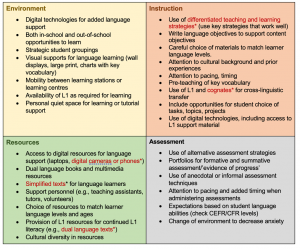
Permission: Courtesy of Nadia Prokopchuk, Department of Curriculum Studies, University of Saskatchewan based on Saskatchewan Ministry of Education (2017). The Adaptive Dimension for Saskatchewan K–12 Students.
Video explanations of the items in the chart marked in red with an *asterisk are available here:
- Colorin Colorado. (n/d). Teaching Vocabulary with Digital Cameras. https://www.colorincolorado.org/classroom-video/teaching-vocabulary-digital-cameras
- BBC Learning English website. Main site: https://www.bbc.co.uk/learningenglish/
- BBC Learning English website. Simple stories for children, audio-visual plus transcript: https://www.bbc.co.uk/learningenglish/english/features/childrens-stories
- BBC Learning English website. Podcasts for older learners: 6 minute English: https://www.bbc.co.uk/programmes/p02pc9tn/episodes/downloads
- Unite for Literacy Project (n/d). English/Spanish books available online with narration. https://www.uniteforliteracy.com/
- Prodigy Education (Ontario). (n/d) 15 Differentiation Strategies. https://www.youtube.com/watch?v=dbofSpSQR3c
- Colorin Colorado. (n/d). Using Cognates to Develop Comprehension in English. https://www.colorincolorado.org/article/using-cognates-develop-comprehension-english
- Coloring Colorado. (n/d). Amber Prentice: Using Cognates in ELL Classrooms. https://www.colorincolorado.org/guide/cognate-list-english-and-spanish
Review Your Learning
- Explain the purpose of a learner profile or learner portfolio.
- Identify learning styles that impact each student’s success in the classroom.
- Organize strategies for differentiating learning into four categories: instruction, assessment, environment, and resources.
- Examine ways to adapt resources to meet the language proficiency levels of diverse students in a language program.
Module 7 Glossary
Alternative assessment: Approaches to monitoring student learning that consider a learner’s specific circumstances, challenges, or language learning needs, resulting in an expansion of ways to assess student progress.
Code switching: A term used to describe the ability to alternate between two or more languages in the context of oral communication.
Differentiation: Adjusting, adapting, or tailoring instruction to meet a learner’s individual needs.
Fossilization: A broad term used to describe recurring errors or incorrect patterns of speech, often the result of multiple incorrect repetitions that have become ingrained in the mind.
Language distance: The extent to which two languages are similar or different from each other.
Learner profile (learner portfolio): A collection of important information about the student, as well as samples of student work that illustrate progress with learning.
Silent period: Describes the initial stage of language learning when students prefer to observe and absorb the new language rather than trying to speak.
Speech-language impairment (SLI): Describes a communication disorder that adversely affects a child’s ability to succeed in school.
Translanguaging: The use of two or more languages from one’s personal repertoire to support communication, access information or facilitate understanding.
References
Coelho, E. (2016). Chapter 8: Understanding Second Language Acquisition. In Adding English. A Guide to Teaching in Multilingual Classrooms. Second Edition. University of Toronto Press. pp. 153-182.
Fairbairn, S. & Jones-Vo, S. (2010). Chapter 1. Differentiation for English Language Learners: Key Considerations. In Differentiating Instruction and Assessment for English Language Learners. A Guide for K-12 Teachers. Carlson Publishing. Philadelphia. pp.1-39.
NALDIC (2016). What is translanguaging? EAL Journal. https://ealjournal.org/2016/07/26/what-is-translanguaging/
Prokopchuk, N. (2021). The CEFR/CFR Reference Scale: A Practical Tool for Assessing Language Skills in an Additional Language. Chart. College of Education, University of Saskatchewan.
RALLI campaign Bilingualism and SLI. (2013). Can bilingual children have speech-language impairments (SLI)? Raising Awareness of Language Learning Impairments (RALLI). https://www.youtube.com/watch?v=g7Sj_uRV7S4&sns=tw (5:24 min.)
University of Massachusetts. (2022). How to Accommodate Different Learning Styles. Dartmouth. https://www.umassd.edu/dss/resources/faculty-staff/how-to-teach-and-accommodate/how-to-accommodate-different-learning-styles/

